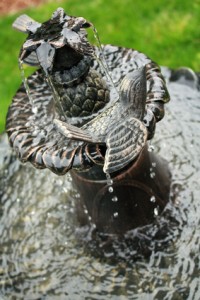 Water features come in all shapes and sizes, from tabletop fountains to the powerful, towering jets at The Bellagio in Las Vegas. Obviously, the construction of large water features is best left to the professionals, but for smaller projects, it’s possible to design a DIY water feature in a single afternoon.
Water features come in all shapes and sizes, from tabletop fountains to the powerful, towering jets at The Bellagio in Las Vegas. Obviously, the construction of large water features is best left to the professionals, but for smaller projects, it’s possible to design a DIY water feature in a single afternoon.
This article will outline some of the things you should consider before shopping for materials and building a DIY water feature.
Style and Materials
The materials you use for your DIY water feature should complement the materials and style of your home and garden. For example, if your home is formal, symmetry, formal shapes, and classic materials such as concrete basins and finials will look best in your garden.
If your home is more rustic or located in a more natural setting, a water feature made to look like a natural creek bed may be more fitting.
Scale and Proportion
How much space do you have for your DIY water feature? How will the water feature be viewed, and what kind of statement do you want to make? For example, if you live in an apartment or condo and you want to build a DIY water feature for your balcony, the space may be tight, and you could probably create a DIY water feature using a couple of small, ceramic or concrete pots. However, in the same space, you may want to make a grand statement and construct a taller wall fountain instead. The scale and proportions should be in keeping with the feeling and aesthetic you are trying to create.
When thinking about scale and proportion, also think about how the water feature will be viewed in relationship to your home. You don’t want the water feature or your house to look too big or too small when seen together.
Also consider how the water feature will be viewed. Will it be seen from a few feet away or 50 feet away? Obviously, a water feature that is farther away will need to be larger or it may not have the visual impact it needs. It would be a shame to spend time building a water feature and then realize that it’s too small to get any attention.
Basins and Pools
Water features can be constructed using a variety of materials. A simple DIY water feature can be constructed using a ceramic pot and a bamboo spigot. Concrete or ceramic pots are one option. Formed concrete basins can be built for larger projects. These can be left unfinished, finished with ceramic tiles, or colored using stains or integral color. For natural-looking, pond and creek bed designs, you will need a pond liner of flexible PVC. Whatever material you choose, your pond needs to be as watertight as possible. The point is, a DIY water feature does not have to be complicated, but the materials you choose should be appropriate to the size, scale, and complexity of the project.
Water Volume and Pumps
Just like the tiny pumps in a fish tank, the pump you use in your DIY water feature will be submerged in water. Typically, the pump is located in the lowest basin of water. For example, if you create a basin with a tiered fountain, the pump will sit in the basin at the bottom and pump water up to the top tier. The water then falls down over the tiers simply through the force of gravity.
The pump for your DIY water feature needs to be the appropriate size. Fountain pumps are sized by gallons per hour (gph) and usually have a small knob on the top or side that allows you to adjust the flow of water. For a small water feature, like the pot with bamboo spigot as mentioned above, a 20- to 40-gph pump will be large enough. If you are moving larger volumes of water, however, you will need to spend more to get a pump that can move more water volume per hour.
Safety Concerns
Children should never be left alone near a water feature as they can drown in a very small amount of water. Keep this in mind when designing your DIY water feature. For families with small children, a water feature that recirculates using a closed reservoir of water and without an open pool may be best.
Pool regulations require a fence around open water beyond certain depths. Check your federal, state, and local regulations before constructing any DIY water feature.
Planting Around Your DIY Water Feature
Finally, depending on the style and location of your water feature, you may want to plant around the edges. This is especially important if you have constructed a natural, creek bed water feature. A water feature of this type should be planted with native plants from your area. In general, it is best to use plants that like moisture. Although you have done your best to make your water feature watertight, it will lose a bit of water every day from splashing and evaporation. Plant a combination of shrubs, trees, and perennials that will not be adversely affected by this additional water.
The sound of water in the garden can sooth the nerves and block unwanted neighboring noises. Whatever your reasons for constructing a DIY water feature, the above design considerations should get you started.
